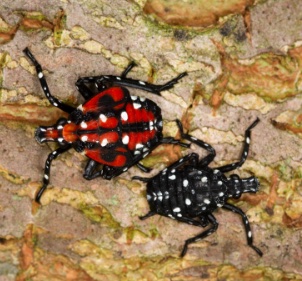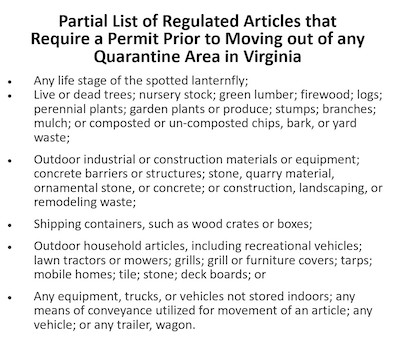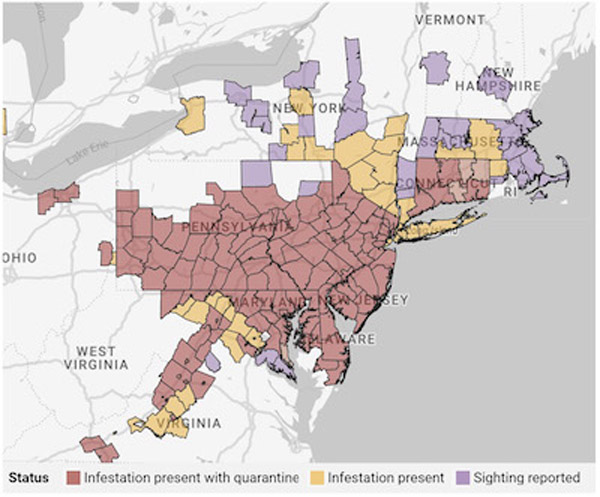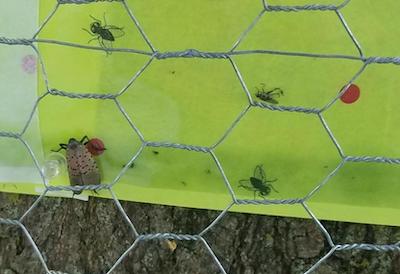Now Arriving in Fairfax County
Spotted Lanternflies: What to Look For
by Ann M. Mason, Fairfax Master Gardener

Spotted lanternfly nymphs
The march of the Spotted Lanternflies (Lycorma delicatula) expanded and reached Fairfax County. Fairfax County joins surrounding counties, [Loudoun and Prince William counties in Virginia and Montgomery and Charles counties in Maryland] in reporting confirmed infestations of the Spotted Lanternfly.
The state of Pennsylvania first reported the presence of Spotted Lanternflies in the United States in 2014. Since then, lacking natural predators and diseases, these invasive pests are spreading throughout the eastern U.S.

Regulated Articles
To slow the movement of these highly mobile pests, many states require businesses to comply with regulatory requirements when moving goods between states. Businesses in Virginia must get a permit from the Virginia Department of Agriculture and Consumer Services (VDACS) to move regulated articles from counties with Spotted Lanternfly infestations.
VDACS maintains a public list of those with Spotted Lanternfly Permits on its website listed below in the Resources.
With the confirmation of an infestation, we can expect the addition of Fairfax County to Virginia’s quarantine list in the future.

Counties with Spotted Lanternfly
What Should Fairfax County Residents Do if They See a Spotted Lanternfly?
First, kill the insect(s) if you can. Squash, stomp, pinch, and deposit in the trash. [If you feel the need to take chemical controls, follow the control recommendation from Virginia Tech (VT) later in this article.] Scrape egg masses off and deposit in rubbing alcohol and dispose the container in the trash.
Then, Fairfax County officials ask residents to report the location and date of any sightings to iNaturalist through its mobile app or to the county’s Urban Forestry Department by email to ReportSLF@fairfaxcounty.gov
What is a Spotted Lanternfly?
The Spotted Lanternfly is a leafhopper, an insect with mouth parts to suck plant sap out of leaves, stems, and tree trunks, and with strong hind legs for jumping. The life cycle of the Spotted Lanternfly consists of eggs, nymphs, which go through four molting stages (instars), and adults.
Spotted Lanternfly are known to feed on many different types of plants, with a particular taste for its preferred hosts, the Tree of Heaven (Ailanthus altissima) and the common grape. The nymphs and adults have a strong preference for economically important plants to Virginia crops including grapes, hops, apple, and stone fruits [peach, cherry as well as ornamental woody and herbaceous plants.
The exact relationship between the Spotted Lanternfly and the fast-growing plant, Tree of Heaven, is unknown and ongoing. Currently, scientists speculate that during feeding the Spotted Lanternfly consumes chemical repellants (the bitter quassinoid compounds) that makes this pest less appetizing to bird predators.
Like other leafhoppers, the mouthparts of the Spotted Lanternfly pierce the plant’s phloem to suck the plant sap. The insect excretes honeydew, a sugar rich sticky liquid, that sticks to the trunk, stem, and other plant parts. Honeydew attracts other insects like ants, mosquitoes, wasps, and bees. Honeydew can cause sooty mold, a dark colored fungi that coats the leaves and other plant parts, limiting photosynthesis and harming the plant. Residents find honeydew is hard to clean off cars and other objects.
In 2020 entomologists, Lawrence Barringer and Claire Ciafré, published a list of 103 host plants for the Spotted Lanternfly that included 20 new plants. Their list included maples, walnut, birches, dogwoods, willow, horseradish, blueberry, and plants including Bee balm, Virginia creeper, perennial salvia, even poison ivy, and many others.
These entomologists report that researchers, who are cultivating colonies of Spotted Lanternfly to study their behavior in North America, observed that small numbers of adults quickly wilted cuttings of woody plants. Based on this finding, researchers speculate that small herbaceous plants could support only a few insects, especially at the later instar stages. They also report that the Spotted Lanternfly appears to prefer plants with a similar sugar content ratio to that in the Tree of Heaven and the common grape vine. Research is ongoing to clarify the feeding preferences and to identify possible new plant hosts in North America. What is clear is the Spotted Lanternfly has a broad appetite and is adapting to North American plants as it expands its range.
What Can Residents Do to Limit the Spotted Lanternfly?
Virginia Tech (VT) scientists report that successful control depends on the proper timing and effective use of chemical or biological controls. They caution that leafhoppers like the Spotted Lanternfly easily move out of treated areas to another tree or plant and from ground level to higher in trees and will reoccupy treated plants after the chemicals dissipate.

Best management practices for spotted lanternfly
Knowing the timing of the expected life stage can help follow VT treatment recommendations. Entomologists report there is one generation per year. VCE postcard image Adults die in the winter. But researchers report that the eggs will survive temperatures down to -14 F. Our Virginia winters do not approach that temperature.
In November through April, residents need to look for egg cases on tree trunks, grills and outdoor furniture, car wheel wells, roofs, cargo holds and other possible sites. Scrape the egg masses into a container filled with rubbing alcohol or hand sanitizer. Dispose of this container in the trash. NOTE: Experts advise egg masses need to be fully submerged in the alcohol; if not submerged the eggs can still hatch!
In May through June, watch for creeping black nymphs with white spots. The nymphs will molt three times. The first three instar nymphs will be black with white spots. During each sequential molt the nymph will grow from its initial 1/4 inch (5 mm). The black and white nymphs feed constantly on annual or perennial herbaceous plants. In the last molt the fourth instar nymph will emerge as a 3/4 inch (20 mm) red and black nymph with white spots. Armed with stronger beaks the fourth instar nymph and adults will feed on woody plant materials.
Starting in July through December, the red and black nymph will molt; the 1-inch (25mm) adult will emerge. Both male and female adults have yellow abdomens with black stripes. Adult females are identified by the red spots on the abdominal segments at the ovipositor end of the abdomen.
Starting in September through November or until the first killing frost, female adults will lay eggs in 1-inch segmented rows that she will cover with a creamy white substance that will turn gray as it dries, resembling mud. Each egg mass can contain many eggs. Expert sources report different numbers: some say 30 to 60 eggs, others say 20 to 30 eggs per mass. Of note, the female does not discriminate — she will lay eggs on any outdoor surface — a lot of eggs!
Control is Targeted and Timing Specific
Kill individual nymph or adult Spotted Lanternflies by squeezing, stomping or other mechanical means. Large numbers are dismaying. VT recommends a combination of methods to manage the large numbers of Spotted Lanternflies.

Sticky band covered with wire or mesh
University experts in many states suggest the use of a sticky band wrapped around tree trunks 4 feet from the ground. Secure the band tightly to the trunk using push pins or stapling it. The experts caution that while the band can catch Spotted Lanternfly, it can catch beneficial insects, birds, butterflies and other untended creatures. They advise adding a wire mesh such as chicken wire over the sticky surface to limit the contact with the sticky surface for larger animals. They also suggest cutting the sticky band into half or thirds to limit the sticky surface area and make the band material go further.
Penn State researchers have collected observations from citizen scientists about the North American species that are starting to get a taste for this bitter invader. In their initial report, the leading bird predators include chickens, cardinals, gray catbirds, blue jays and the tufted titmouse. For insects, they report praying mantis (native and non-native genus in the family Mantidae), yellow jacket, orb weaver spiders, wheel bug and ants. For other species they received evidence that squirrels, bats, frogs (Rana , goldfish and garter snakes appear to be predators. These researchers are collecting more observations to verify these initial sightings. Penn State and other experts report that our North American predators alone are unlikely to reduce or eliminate Spotted Lanternfly populations.
Residents of Fairfax County are joining the residents of New York, Pennsylvania, New Jersey, and other states in the battle against Spotted Lanternflies and to maintain our landscape plantings. Researchers from many states are trying to determine mechanisms to manage the populations of this pest. What is clear is that we can be vigilant and take early action in our own yards and communities. One key step is that residents eliminate the Tree of Heaven, closely examine outdoor materials, manage the populations in your yard and observe all quarantine guidelines.
Resources
• Regulations for Enforcement of the Virginia Tree and Crop Pests Law–Spotted Lanternfly
Quarantine, Virginia Administrative Code, Title 2, Department of Agriculture and Commerce
• Virginia Department of Agriculture and Consumer Services, maintains a public list of those
with Spotted Lanternfly Permits on its website
• Report Location, mobile app for residents to report the location and date of any sightings to
iNaturalist
• Best Management Practices for Spotted Lanternfly in Yards and Landscapes, Virginia Cooperative
Extension, Publication ENTO-344NP
• Worldwide Feeding Host Plants of Spotted Lanternfly, with Significant Additions from North
America, Barringer, L and Ciafré, C, Environmental Entomology, Vol 49, Issue 5, October 2020
• PSU News, Advice on using tree bands